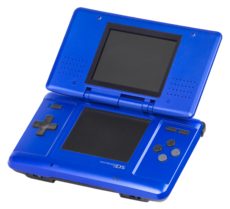| Nintendo DS | |
|---|---|
  | |
| Manufacturer | Foxconn |
| Type | Handheld video game console |
| Generation | Seventh generation |
| First available | |
| Media | ROM cartridge |
| Predecessor | Game Boy Advance |
| Successor | Nintendo 3DS |
| Article on Nintendo Wiki | Nintendo DS |
The Nintendo DS universe refers to the Super Smash Bros. series' collection of stages and properties that hail from the default software on Nintendo's Nintendo DS handheld video game system.
Franchise description
Development for the console started at some point in 2002 when former Nintendo President Hiroshi Yamauchi had the idea of a video game console that uses two different screens simultaneously.[1] Nintendo announced in 2003 that a new console would launch in 2004. They made it clear that this new project would not be a replacement for the currently available Game Boy Advance or GameCube, but rather an alternative that would act as a third pillar for sales. The DS became an instant success due to the novelty of its features, relatively low price at launch, and strong collection of launch titles. The DS would receive several hardware revisions:
- Nintendo DS Lite: a drastically redesigned exterior and improved hardware across the board.
- Nintendo DSi: introduces two cameras and access to the DSi shop, but removes the GBA slot; therefore GBA games and DS games that use the GBA slot are not playable.
- Nintendo DSi XL: includes all the features of the DSi, now with larger screens.
All versions of the DS combined would eventually sell 154.02 million units, making it the best selling Nintendo console, the best selling handheld game console, and the second best selling video game console ever, only being outsold by the PlayStation 2 exceeding 155 million units. The DS received a proper successor in 2011 called the Nintendo 3DS, which retained a majority of the features from the DSi and itself spawned a lineage of revisions. The DS also inspired elements of other consoles like the Wii U and Nintendo Switch.
The DS was the first Nintendo console to have proper firmware, complete with a clock with an alarm, user information inputs, and a home screen. At this screen, the player has the option to play a DS game, select Download play if they are near another DS with a compatible game, or play a Game Boy Advance game on compatible models through its dedicated slot. The one built in software for the system is PictoChat a social network service where friends can send messages and pictures between each other as long as they are in range. While GameCube was technically the first Nintendo console to have online capabilites, the DS introduced the Nintendo Wi-Fi Connection, a dedicated online service for compatible games. The DSi specifically had six games exclusive to those models as well as built-in applications such as the DSi Camera and the DSi shop, from which exclusive games and software could be downloaded to the system or an SD card.
In Super Smash Bros. Brawl
The Nintendo DS is recognized as its own universe by Super Smash Bros. Brawl.
Stage
- PictoChat (Starter): Based on the PictoChat software built into every Nintendo DS, this stage evokes the whimsical doodling element of the software. While it is, at its base form, a completely flat stage, scenery and new elements are quickly drawn onto the stage and then erased and replaced as quickly as they appear, creating an ever changing battlefield.
Music
In Super Smash Bros. for Nintendo 3DS
The Nintendo DS universe makes a return in Super Smash Bros. for Nintendo 3DS. While the original PictoChat stage does not appear, it is replaced by a similar, updated version.
Stage (for Nintendo 3DS only)
- PictoChat 2 (Starter): A new stage similar to the previous PictoChat, featuring different drawings which introduce new stage elements.
Music
In Super Smash Bros. Ultimate
Stage
- PictoChat 2 (Starter): Returns as a retro stage. The stage received more brightness compared to its original version from Smash for 3DS, now matching PictoChat's background color from the hardware.
Music
Returning track
- PictoChat: An original, piano-based theme, featuring sound effects from the Nintendo DS and Nintendo DS Lite menu, the Wii menu, and PictoChat. Returns from Brawl.
Trivia
- If the Game Boy Color is counted as a variation of the original Game Boy, as it is in the Chronicle and in trophy descriptions, the Nintendo DS is the only Nintendo system to be the console of origin for only one playable character, that being Lucario.
- The Nintendo DS and Miiverse are the only universes solely represented by a stage to not have an in-game collectible (i.e trophies and spirits) related to it in any Smash game.
References
| Nintendo consoles | |
|---|---|
| Home consoles | Color TV-Game 15 · Nintendo Entertainment System · Super Nintendo Entertainment System · Virtual Boy · Nintendo 64 · Nintendo GameCube · Wii · Wii U |
| Handheld consoles | Game & Watch · Game Boy · Game Boy Color · Game Boy Advance · Nintendo DS · Nintendo 3DS |
| Hybrid consoles | Nintendo Switch |
| Nintendo DS universe | |
|---|---|
| Stages | PictoChat · PictoChat 2 |